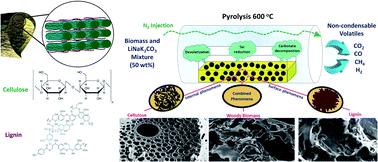当前位置:
X-MOL 学术
›
Sustain. Energy Fuels
›
论文详情
Our official English website, www.x-mol.net, welcomes your
feedback! (Note: you will need to create a separate account there.)
The impact of carbonate salts on char formation and gas evolution during the slow pyrolysis of biomass, cellulose, and lignin
Sustainable Energy & Fuels ( IF 5.0 ) Pub Date : 2020-10-03 , DOI: 10.1039/d0se01031f Tahereh Jalalabadi 1, 2, 3, 4, 5 , Matthew Drewery 1, 2, 3, 4, 5 , Priscilla Tremain 1, 2, 3, 4, 5 , John Wilkinson 1, 2, 3, 4, 5 , Behdad Moghtaderi 1, 2, 3, 4, 5 , Jessica Allen 1, 2, 3, 4, 5
Sustainable Energy & Fuels ( IF 5.0 ) Pub Date : 2020-10-03 , DOI: 10.1039/d0se01031f Tahereh Jalalabadi 1, 2, 3, 4, 5 , Matthew Drewery 1, 2, 3, 4, 5 , Priscilla Tremain 1, 2, 3, 4, 5 , John Wilkinson 1, 2, 3, 4, 5 , Behdad Moghtaderi 1, 2, 3, 4, 5 , Jessica Allen 1, 2, 3, 4, 5
Affiliation

|
This study deals with the modification of chars derived from different biomass samples (woody biomass, cellulose and lignin). Chars are formed during slow pyrolysis on addition of alkali ternary eutectic salts (Li2CO3: 43.5%, Na2CO3: 31.5%, K2CO3: 25% mol), subjected to two different higher heating temperatures (350 °C and 600 °C). It is shown here that the addition of a carbonate eutectic affects char-making reactions through: tar generation modification, changes in the emitted volatile molecules, alteration of surface oxygenate bonds as well as transformation in the morphology of the remnant char. Initial results using Differential Thermal Gravimetric Analysis (DTG) show that, in carbonate treated samples, char yield is increased at both temperatures investigated. In treated cellulose, a reduced temperature onset of mass loss is observed, expected to be from modified depolymerisation and inhibition of levoglucosan formation for samples heated to both 350 °C and 600 °C. Gas analysis by micro-GC proves that carbonate is involved in the cracking of condensable volatiles, which generates a highly porous char structure and increases the emission of non-condensable volatiles. In addition, SEM results for carbonate treated cellulose demonstrate extensive pore generation including both surface and internally generated pores and interconnected tunnel-like structures at higher temperature (600 °C). This was not reflected however in BET results due to the melted salt blocking the available internal porous structure. Improvement in BET results for chars produced at 600 °C was regardless seen on carbonate addition in both biomass (improving from 371 m2 g−1 to 516 m2 g−1) and lignin (improving from 11 m2 g−1 to 209 m2 g−1).
中文翻译:

在生物质,纤维素和木质素缓慢热解过程中,碳酸盐对焦炭形成和气体释放的影响
这项研究涉及对来自不同生物量样品(木质生物量,纤维素和木质素)的焦炭的改性。在缓慢热解过程中,加入碱金属三元共晶盐(Li 2 CO 3:43.5%,Na 2 CO 3:31.5%,K 2 CO 3:25%mol),经受两种不同的较高加热温度(350°C和600°C)。此处显示出,碳酸盐共晶的添加通过以下方式影响焦炭反应:焦油生成改性,释放的挥发性分子发生变化,表面含氧键的变化以及残炭形态的转变。使用差示热重分析(DTG)的初步结果表明,在碳酸盐处理的样品中,在所研究的两个温度下,焦炭收率均提高。在处理过的纤维素中,观察到质量损失降低的温度开始,这可能是由于加热至350°C和600°C的样品改性解聚和抑制左旋葡聚糖形成所致。通过微型气相色谱仪进行的气体分析表明,碳酸盐参与了可冷凝挥发物的裂解,产生高度多孔的炭结构,并增加了不可冷凝挥发物的排放。此外,碳酸盐处理过的纤维素的SEM结果表明,在较高温度(600°C)下,广泛的孔产生包括表面和内部产生的孔以及相互连接的隧道状结构。但是由于熔融盐阻塞了可用的内部多孔结构,因此在BET结果中没有反映出来。无论在两种生物质中添加碳酸盐如何,在600°C下生成的炭的BET结果均得到改善(从371 m 碳酸盐处理过的纤维素的SEM结果表明,在较高温度(600°C)下,大量的孔产生,包括表面和内部产生的孔以及相互连接的隧道状结构。但是由于熔融盐阻塞了可用的内部多孔结构,因此在BET结果中没有反映出来。无论在两种生物质中添加碳酸盐如何,在600°C下生成的炭的BET结果均得到改善(从371 m 碳酸盐处理的纤维素的SEM结果表明,在较高的温度(600°C)下,大量的孔产生,包括表面和内部产生的孔以及相互连接的隧道状结构。但是由于熔融盐阻塞了可用的内部多孔结构,因此在BET结果中没有反映出来。无论在两种生物质中添加碳酸盐如何,在600°C下生成的炭的BET结果均得到改善(从371 m2 g -1至516 m 2 g -1)和木质素(从11 m 2 g -1至209 m 2 g -1改善)。
更新日期:2020-11-03
中文翻译:

在生物质,纤维素和木质素缓慢热解过程中,碳酸盐对焦炭形成和气体释放的影响
这项研究涉及对来自不同生物量样品(木质生物量,纤维素和木质素)的焦炭的改性。在缓慢热解过程中,加入碱金属三元共晶盐(Li 2 CO 3:43.5%,Na 2 CO 3:31.5%,K 2 CO 3:25%mol),经受两种不同的较高加热温度(350°C和600°C)。此处显示出,碳酸盐共晶的添加通过以下方式影响焦炭反应:焦油生成改性,释放的挥发性分子发生变化,表面含氧键的变化以及残炭形态的转变。使用差示热重分析(DTG)的初步结果表明,在碳酸盐处理的样品中,在所研究的两个温度下,焦炭收率均提高。在处理过的纤维素中,观察到质量损失降低的温度开始,这可能是由于加热至350°C和600°C的样品改性解聚和抑制左旋葡聚糖形成所致。通过微型气相色谱仪进行的气体分析表明,碳酸盐参与了可冷凝挥发物的裂解,产生高度多孔的炭结构,并增加了不可冷凝挥发物的排放。此外,碳酸盐处理过的纤维素的SEM结果表明,在较高温度(600°C)下,广泛的孔产生包括表面和内部产生的孔以及相互连接的隧道状结构。但是由于熔融盐阻塞了可用的内部多孔结构,因此在BET结果中没有反映出来。无论在两种生物质中添加碳酸盐如何,在600°C下生成的炭的BET结果均得到改善(从371 m 碳酸盐处理过的纤维素的SEM结果表明,在较高温度(600°C)下,大量的孔产生,包括表面和内部产生的孔以及相互连接的隧道状结构。但是由于熔融盐阻塞了可用的内部多孔结构,因此在BET结果中没有反映出来。无论在两种生物质中添加碳酸盐如何,在600°C下生成的炭的BET结果均得到改善(从371 m 碳酸盐处理的纤维素的SEM结果表明,在较高的温度(600°C)下,大量的孔产生,包括表面和内部产生的孔以及相互连接的隧道状结构。但是由于熔融盐阻塞了可用的内部多孔结构,因此在BET结果中没有反映出来。无论在两种生物质中添加碳酸盐如何,在600°C下生成的炭的BET结果均得到改善(从371 m2 g -1至516 m 2 g -1)和木质素(从11 m 2 g -1至209 m 2 g -1改善)。











































 京公网安备 11010802027423号
京公网安备 11010802027423号